Innovative Wardrobe Ideas for Small Bedrooms
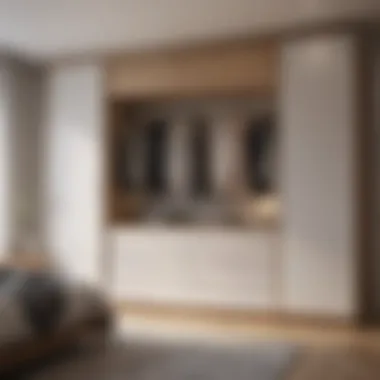
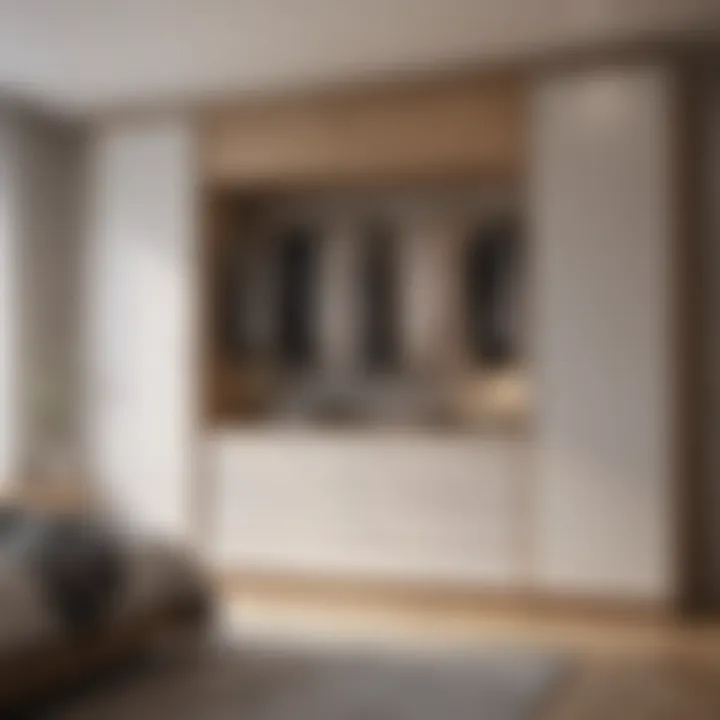
Intro
In the context of urban living and compact homes, the significance of wardrobe solutions becomes pronounced. Small bedrooms often limit storage possibilities, making it essential to consider innovative wardrobe ideas. These ideas can help in optimizing space while maintaining style and functionality. Proper wardrobe design and organization can transform a cluttered environment into a serene sanctuary. This article delves into the nuances of wardrobe creations tailored specifically for small bedrooms.
Design Inspirations
Trending Styles
When it comes to wardrobe design for small bedrooms, current trends lean towards simplicity and functionality. Minimalist styles are particularly popular, emphasizing clean lines and an uncluttered appearance. Some elements to consider include:
- Sliding doors: They save space and allow for easier access to clothing.
- Built-in wardrobes: These can be customized to fit perfectly in available space, maximizing storage options.
- Open shelving: This trend incorporates visibility and makes organization easy. It also allows personal items to serve as decor.
Color Palettes
Choosing the right color palette can make a significant difference in how a space is perceived. Lighter shades like soft whites or pastels can open up a room, making it feel larger than it is. In contrast, darker colors provide a rich depth, which could be utilized as accents. Consider these approaches:
- Monochromatic schemes: These maintain a cohesive look and can enhance the illusion of space.
- Accent colors: Adding vibrant hues through small decor pieces can bring life to an area without overwhelming it.
Maintenance and Upkeep
Seasonal Maintenance Checklist
Proper upkeep ensures that wardrobes remain functional and visually pleasing. Creating a seasonal maintenance checklist can help in evaluating needs:
- Spring: Declutter and donate items no longer needed. Check for signs of wear and tear.
- Summer: Organize summer clothes vis-à-vis storage of winter wear. Clean shelves for dust accumulation.
- Fall: Prepare for colder months by transitioning clothes appropriately. Ensure that all hanging items are secure.
- Winter: Assess durability against cold weather; refresh storage boxes with mothballs or dryer sheets.
Cleaning and Organization Tips
Maintaining a clean wardrobe involves both actionable techniques and organization methods:
- Use organizers: Drawer dividers and small bins can significantly streamline the storage process.
- Regular cleaning: Dust and wipe down surfaces every month to prevent build-up.
- Seasonal recalibration: Changing wardrobes seasonally can help ensure clothes are properly stored and easy to access.
Implement these cleaning tips to prolong the life of your wardrobe and maintain a tidy space.
Understanding the Challenges of Small Bedrooms
The challenge of small bedrooms is substantial for many homeowners and renters. Space often feels limited, making it hard to fit in necessary furniture, especially wardrobes. Understanding these challenges is a foundation for finding effective solutions. A well-designed wardrobe can not only serve its primary function of storage but also contribute to the overall aesthetic appeal and functionality of a small space. This section explores how identifying space constraints and assessing storage needs reveal pivotal insights into creating efficient wardrobe solutions.
Identifying Space Constraints
In small bedrooms, space is often at a premium. Identifying these constraints is crucial. It involves analyzing the room’s dimensions, location of windows, doorways, and electrical outlets. Each of these factors plays a significant role in wardrobe placement. Additionally, the height of the ceiling should not be overlooked.
Employing a space planner tool can be beneficial in visualizing the room's layout. Homeowners may also consider marking out the physical dimensions on the floor, allowing for a clearer picture of what can realistically fit. Common space constraints include:
- Limited floor area
- Low ceilings
- Natural light sources that must remain unobstructed
- Existing pieces of furniture that cannot be moved
Focusing on dimensions and configurations can point to wardrobe types that will work best in the available space, leading to effective choices that avoid overcrowding.
Assessing Storage Needs
Once space constraints are understood, the next step is to assess the storage needs of the individual or family. This evaluation considers what items must be stored, how often they are used, and the best way to organize them. Often, people find they have more items than they originally thought. This can lead to a realization that additional functional elements need to be incorporated into the wardrobe.
Questions to consider are:
- What types of clothing and accessories need storage?
- Are seasonal items being stored, and how often are they rotated?
- Is there a need for specialized storage for shoes or bags?
List of potential storage solutions includes:
- Adjustable shelving
- Hanging racks
- Drawers for smaller accessories
Assessing these needs allows for tailored solutions, ensuring that every inch of space is used effectively. Thus, the wardrobe can be more than just a place to hang clothes; it becomes an organized hub that reflects one’s lifestyle and priorities.
The Importance of Wardrobe Design
In small bedrooms, effective design is more than just a choice; it is a necessity. Wardrobe design plays a crucial role in maximizing limited space while ensuring a functional and aesthetically pleasing environment. A well-thought-out wardrobe not only enhances the organization of clothing and accessories but also contributes to the overall ambiance of the room. The careful selection of materials, styles, and placement can transform a cramped space into a harmonious refuge.
Aesthetic Considerations
A wardrobe is often one of the most noticeable pieces of furniture in a bedroom. Therefore, its design directly affects the room's overall look. When selecting a wardrobe, homeowners should consider how its design flows with existing elements in the space. This involves paying attention to:
- Style Compatibility: Choose a wardrobe that aligns with the interior design theme, whether it is modern, rustic, or minimalist.
- Color Coordination: Light or neutral colors can make a small room appear larger, while darker hues can add a touch of elegance but may also make the space feel narrower.
- Material Choice: The type of material selected can impact both durability and aesthetic appeal. Wood evokes warmth, while metal may provide a sleek, contemporary feel.
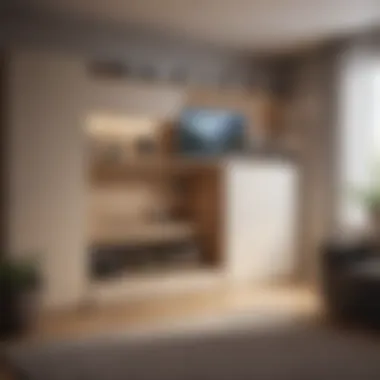
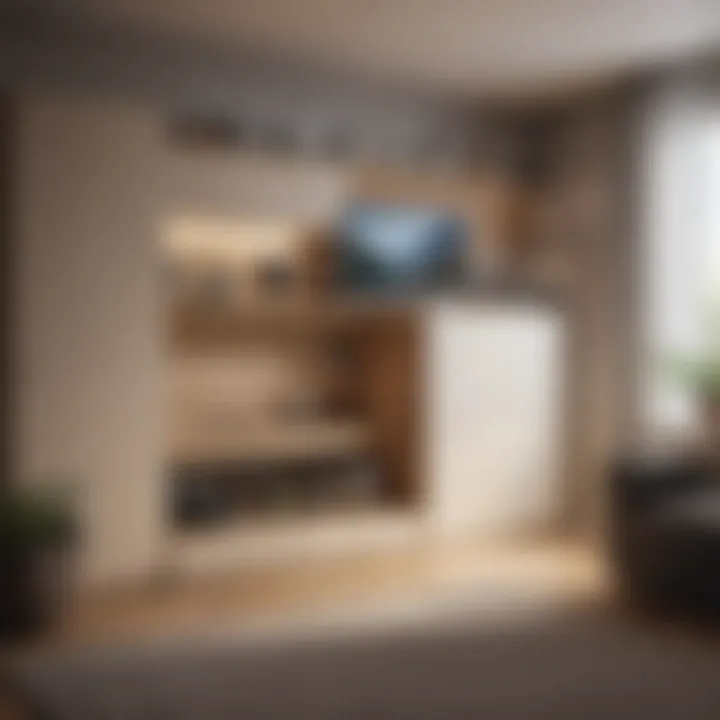
Incorporating other design elements such as mirrors can enhance visual space. A mirrored wardrobe door not only adds a functional aspect of reflection but also aids in creating an airy atmosphere. Ultimately, the wardrobe should complement and enhance the bedroom's design rather than overpower it.
Functional Aspects
Beyond aesthetics, a wardrobe needs to serve practical purposes efficiently, especially in limited spaces. The following aspects must be examined to maximize functionality:
- Space Utilization: Smart design leverages vertical space. Wardrobes that extend from floor to ceiling help in storing more items without requiring additional floorspace.
- Internal Layout: Assessing how to best arrange clothing and accessories is vital. Shelves, drawers, and hanging bars should be allocated based on usage frequency. Consider using pull-out or sliding shelves to improve accessibility.
- Flexibility: Modular designs can adapt to changing storage needs over time. As seasons or styles change, the interior configuration should easily adjust.
Effective wardrobe design is about marrying style with utility. It enhances the experience of the user while contributing to the room's overall aesthetic.
Types of Wardrobes for Small Spaces
Wardrobes play a significant role in the functionality and aesthetics of small bedrooms. Choosing the right type can greatly influence both storage capacity and room design. Understanding various wardrobe options is crucial for homeowners looking to optimize their living spaces. The following sections outline three popular wardrobe types suitable for compact areas: built-in, freestanding, and sliding door wardrobes.
Built-In Wardrobes
Built-in wardrobes are custom-fitted into the walls of a room. They maximize space by using every inch available. This design not only hides the clutter but also creates a seamless look. Benefits of built-in wardrobes include:
- Space Optimization: They can be designed to take advantage of overhead and corner spaces that freestanding units might miss.
- Customization: Homeowners can tailor the interior layout to their unique storage needs, such as adding shelves, drawers, or hanging space.
- Aesthetic Cohesion: Built-in wardrobes can be incorporated into the bedroom's decor, blending with the walls and adding to the overall style.
However, they do come with some considerations. The installation process can be complex and requires professional help. Additionally, built-ins can limit flexibility; if you move, they typically stay behind.
Freestanding Wardrobes
Freestanding wardrobes are standalone units that can be placed anywhere in the bedroom. They offer several advantages, particularly in terms of flexibility. Some key benefits include:
- Mobility: Easily moved if you decide to rearrange your space.
- Variety of Styles: Available in numerous designs, materials, and colors, making it easy to find one that fits your style.
- Quick Setup: Generally do not require installation, making them an accessible option for many homeowners.
On the downside, they may take up more floor space compared to built-in variants. Careful selection of size and placement can mitigate this concern.
Sliding Door Wardrobes
Sliding door wardrobes utilize a space-saving design by featuring doors that slide open instead of swinging outwards. This design is particularly advantageous in small bedrooms where swing space is limited. Some of the key benefits are:
- Minimal Space Requirement: They free up space for other furniture or activities inside the room.
- Modern Aesthetic: Often associated with contemporary design, sliding door wardrobes can enhance the visual appeal of the bedroom.
- Versatile Configurations: Similar to built-in wardrobes, they can be customized to include a variety of storage options, such as shelves, drawers, and hanging spaces.
However, maintenance may be required for the sliding mechanisms to function smoothly. Additionally, they can be less accessible than swinging doors in tight spaces.
Choosing the right wardrobe type is essential for making the most of a small space, ensuring efficiency without sacrificing style.
Multi-Functional Furniture Solutions
In small bedrooms, every inch counts. Choosing the right furniture can significantly improve living space without sacrificing style. Multi-functional furniture offers versatile solutions that maximize functionality while enhancing the aesthetic appeal. These furniture items can serve multiple purposes, often combining storage and living space needs effectively.
Bed Frames with Built-In Storage
Bed frames with built-in storage are a practical solution for small bedrooms. These frames often include drawers or compartments beneath the mattress. This design allows for easy access to items while keeping the room tidy. Additionally, many bed frames are crafted to blend seamlessly with the bedroom decor, making them both functional and stylish.
When selecting a bed frame with storage, consider the following:
- Size and Height: Ensure that the dimensions of the frame fit well within the space, leaving room to move comfortably.
- Storage Capacity: Assess how much storage you truly need. Some frames have shallow drawers, while others can accommodate larger items.
- Material: Choose materials that match the overall decor of the room. Options range from wood to metal, each having its benefits.
Ottoman Storage Solutions
Ottomans serve dual purposes in a small bedroom. Their primary function is providing seating or footrest, but they can also house a range of items, from blankets to books. Many ottomans come with removable tops or hinged lids, simplifying the process of accessing stored items.
When integrating ottomans into your space, think about:
- Placement: Positioning can enhance the room's flow. Place them at the foot of the bed or beside a chair for utility.
- Height: Ensure the ottoman’s height is appropriate for what you plan to do with it, whether sitting or storing.
- Style: Select an ottoman that complements other furniture, maintaining a cohesive look.
Convertible Furniture
Convertible furniture is an innovative option for small living spaces. It refers to items that can change their form or function, adapting to various needs. Examples include sofa beds, foldable dining tables, and expandable desks. Such adaptability can be invaluable in a bedroom, where space can quickly become cluttered.
Key considerations for convertible furniture include:
- Ease of Use: Ensure that the converting process is straightforward. Complicated designs may discourage regular use.
- Durability: Examine the quality of materials. Convertible pieces should be as sturdy as traditional furniture.
- Design: The aesthetic appeal should not be overlooked. Well-designed convertible furniture can enhance the room and elevate its style.
Multi-functional furniture not only clears clutter but also elevates the overall style of small bedrooms, achieving harmony between utility and design.
Ultimately, multi-functional furniture solutions provide practical answers to the space constraints faced in small bedrooms. Integrating these items thoughtfully can drastically change one’s living experience.


Creative Organization Techniques
Effective organization is essential in small bedrooms. Without a well-structured wardrobe, a room can become cluttered and disorganized quickly. Creative organization techniques can help maximize storage options while maintaining a clean and aesthetically pleasing space. Understanding various methods allows homeowners and design enthusiasts to utilize every corner of their rooms efficiently.
Utilizing Vertical Space
Most people tend to overlook vertical space when organizing their bedrooms. Using the height of your walls opens avenues for storage that do not encroach on the limited floor area. Shelves above wardrobes, wall-mounted racks, and high cabinets can all contribute to better organization.
A few key benefits of vertical organization include:
- Maximizing Space: You can store more items without overwhelming the room. This reduces the need for larger furniture.
- Visibility: Items placed at eye level are easier to find. It avoids the frustration of digging through drawers.
- Aesthetics: A well-planned vertical layout can add visual interest to your room.
To implement vertical storage, consider the following tips:
- Install floating shelves to display shoes or books.
- Use hooks for bags and accessories, keeping them out of the way but accessible.
- Consider tall bookshelves or cabinets that reach the ceiling.
Drawer Organizers
Another effective method for maintaining organization in a small wardrobe is the use of drawer organizers. These tools help categorize items and prevent chaos inside the drawers. When everything has a designated space, finding what you need becomes simpler and quicker.
The advantages of drawer organizers include:
- Efficiency: Quick access to items saves time during busy mornings.
- Prevention of Overcrowding: Dividing items keeps drawers from becoming overstuffed and unmanageable.
- Customization: Many organizers are adjustable, allowing you to personalize the storage spaces to fit your belongings.
Incorporating drawer organizers can involve:
- Using dividers for items like socks, ties, or undergarments.
- Designing a specific area for accessories like watches or jewelry.
- Implementing stackable bins to separate bulkier items, such as sweaters.
Hanging Systems
Hanging systems are a practical choice for those with limited horizontal storage solutions. They add valuable space while offering flexibility in organizing clothes. A well-installed hanging system can make the most out of your wardrobe's capacity.
Benefits of using hanging systems include:
- Accessibility: Clothes hung on accessible rods allow for quick reviews of your wardrobe.
- Airflow: Hanging prevents clothes from becoming stale or developing wrinkles.
- Flexible Configuration: Rods and hooks can be adjusted as your needs change.
To set up an effective hanging system, consider:
- Using multiple rods for different types of clothing, such as shirts and dresses.
- Employing cascading hangers to keep clothing organized and save space.
- Attaching hooks to hang accessories, bags, or even hats.
Creative organization techniques transform clutter into order, enabling better use of space and ease of access.
Choosing the Right Materials
Selecting the appropriate materials for wardrobes in small bedrooms is crucial. Materials not only affect the overall aesthetics of a room, but they also impact durability and functionality. High-quality materials contribute to the longevity of furniture while ensuring that it fits well within a compact space.
Wood vs. Metal
When deliberating between wood and metal for wardrobes, it is important to consider both attributes and how they align with your needs.
Wood is often favored for its warmth and natural look. It offers a variety of finishes, making it easy to match different decor styles. Moreover, wood is typically sturdier and can support heavier clothing and accessories. A solid wood wardrobe can last for decades, making it a sound investment for any homeowner. Some popular types of wood include oak, maple, and cherry, each providing unique grains and colors.
On the other hand, metal brings a more modern and industrial feel to bedrooms. It can be lightweight, making it easier to move should the space change. Metal wardrobes are less prone to warping compared to wood, especially in humid conditions. However, these can feel colder and may not provide the same level of warmth that wood does. Steel and aluminum are commonly chosen materials, offering a sleek finish and high durability.
Ultimately, the choice between wood and metal comes down to aesthetic preferences as well as practical considerations regarding maintenance and the overall style of the bedroom.
Finishes and Textures
The finishes and textures chosen for wardrobes can greatly influence how spacious a room feels. Light-colored finishes such as white, beige, or soft pastels can enhance lighting effects, creating an airy appearance. Glossy finishes reflect light, adding to the perceived space. Conversely, dark finishes can add depth and richness but may make a small bedroom feel more confined.
Textures can also play an important role. A smooth finish can appear more modern and sleek, while a textured surface, such as distressed wood or brushed metal, can add visual interest without overwhelming the space. Consider combining different textures to create layers in the design. For example, pairing a smooth wooden wardrobe with a textured wall can add complexity without sacrificing simplicity.
Key Insight: When choosing finishes, consider both practicality and aesthetics. High-gloss surfaces can be easier to clean, while matte finishes may be more forgiving of fingerprints and marks.
Color Schemes and Lighting
Color schemes and lighting are crucial elements in small bedrooms. They have the power to influence the perception of space, mood, and overall ambiance. A well-thought-out color palette can create an illusion of a more expansive area, while lighting can enhance the aesthetics and functionality of a wardrobe. In this section, we will discuss the importance of light colors and effective lighting solutions for small bedrooms.
Light Colors for Smaller Spaces
Using light colors in small bedrooms helps in making the space feel larger and airier. Soft hues like whites, light grays, and pastel tones reflect more light, contributing to an open atmosphere. When selecting colors for your wardrobe, consider the following points:
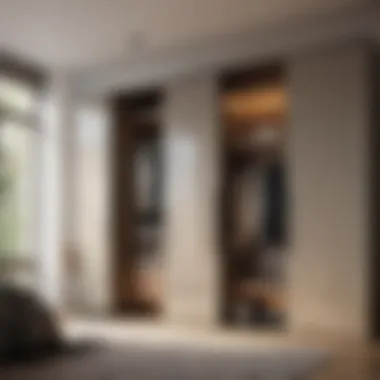
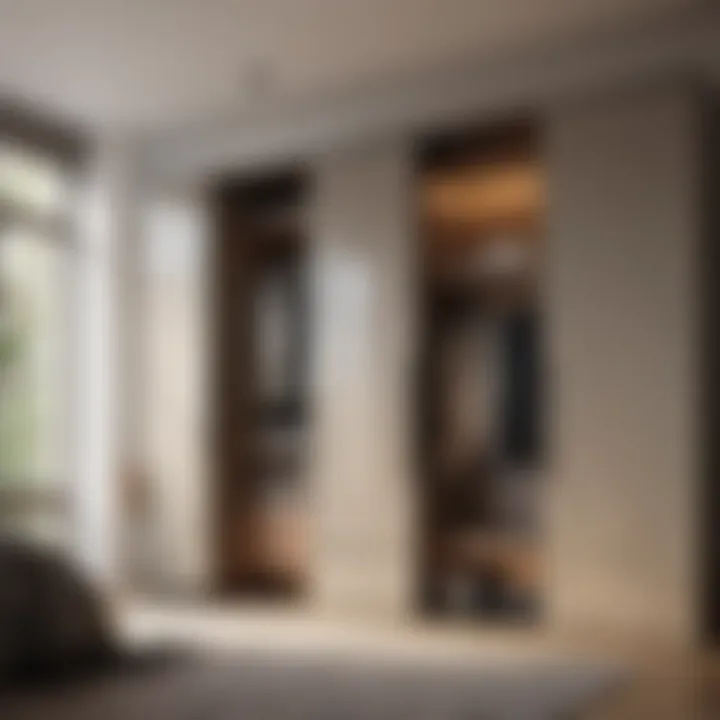
- Reflectiveness: A light-colored wardrobe can amplify available light, making the room appear brighter.
- Cohesion: Harmonizing wardrobe colors with surrounding walls creates a seamless flow, minimizing visual clutter.
- Versatility: Light shades often blend well with various decor styles, allowing for easy customization with accessories.
For instance, painting the wardrobe in a soft beige can complement various bedding styles while maintaining a fresh look. Studies show that lighter colors can alleviate feelings of confinement that usually accompany smaller spaces, leading to a more relaxing environment.
Effective Lighting Solutions
In a small bedroom, effective lighting is indispensable for both functionality and aesthetic appeal. A mix of ambient, task, and accent lighting can provide the right brightness levels needed. Here are some solutions to consider:
- Recessed Lighting: This type of lighting is embedded in the ceiling. It provides a clean, modern look without taking up visual space, allowing for maximum ceiling height.
- Wall Sconces: These fixtures save space on bedside tables while providing targeted lighting for reading or other tasks.
- Under-Cabinet Lighting: Installing lights inside or under wardrobes ensures visibility and makes it easier to find items, enhancing organization efforts.
Consider this: Quality lighting can elevate the wardrobe experience, making it easier to choose outfits or access items without stress.
Combining light colors with effective lighting solutions can refresh the entire space. When thoughtfully executed, these elements will not only enhance a small bedroom's visual appeal but also improve its functionality.
Incorporating Personal Style
Personal style plays a crucial role in the overall design of wardrobes, especially in small bedrooms. When space is limited, it becomes necessary to blend aesthetics with functionality in a thoughtful manner. A wardrobe in a small room should not only serve its primary purpose but also reflect the personality and preferences of the homeowner. This adds a layer of enjoyment and satisfaction in daily living.
Customizable Elements
Customizable elements allow homeowners to express their individuality while maximizing storage solutions. Consider features that can be adjusted to suit both needs and tastes. For example, modular shelving systems provide flexibility in arranging clothes, accessories, and shoes based on specific requirements and styles.
- Adjustable Shelves: These can be moved up or down to accommodate items of varying heights, whether it be shoes, hats, or folded garments.
- Interchangeable Doors: Swapping out solid doors for glass or mirror options can create a spacious feel and add a modern touch.
- Color Customization: Providing options for different finishes or colors allows homeowners to match the wardrobe with the existing decor.
Homeowners should prioritize selecting materials that complement their style while considering the durability needed for daily use. By employing custom features, it's much easier to create a wardrobe that feels unique and personal, significantly improving the visual appeal.
Accessorizing the Wardrobe
Accessorizing plays a vital role in making wardrobes not only functional but also visually appealing. Accessories can highlight individual style and provide additional functionality without taking up more floor space.
Some effective accessories include:
- Hangers: Stylish hangers, such as wooden or velvet, can keep clothing organized and presentable.
- Storage Bins: Decorative bins or baskets can be used to organize smaller items, like accessories or seasonal wear, while adding texture to the design.
- Mirrors: Installing a mirror inside the wardrobe door can enhance the sense of space and provide a practical element for outfit checks.
- Lighting: Soft LED strip lights inside the wardrobe enhance visibility and can highlight the wardrobe's interior, making it an attractive feature.
In summary, incorporating personal style in small bedroom wardrobes is essential for creating spaces that resonate with the homeowners’ tastes. Thoughtful selection of customizable elements paired with well-chosen accessories can transform a simple storage unit into an expression of personal identity.
Practical Examples and Case Studies
In the context of optimizing wardrobes for small bedrooms, practical examples and case studies serve as critical components. These instances provide tangible insights into effective designs and solutions that address the unique challenges faced by homeowners with limited space. By examining real-life applications, we can better understand how specific choices can lead to enhanced functionality, organization, and aesthetic appeal.
Illustrating successful implementations encourages readers to envision similar strategies in their own homes. The benefits of referring to examples are considerable, particularly in a subject where the risk of overcrowding and mismanagement of space is prevalent. Furthermore, case studies can reveal valuable lessons about what works, what doesn't, and how adjustments can make a significant difference.
Real-Life Applications
Real-life applications of wardrobe designs reflect a variety of innovative techniques that have proven successful for many individuals. For instance, consider a small bedroom that utilizes a corner-built wardrobe. This strategy maximizes often-underutilized space, allowing for a seamless integration of storage without intrusive furniture layouts.
Another effective solution has been the installation of a sliding door wardrobe. This option minimizes the clearance needed for door swings, thereby saving crucial floor space while still providing ample storage. In one documented case, a small studio apartment showcased the power of vertical shelving within a wardrobe, allowing for hanging clothes as well as folded items, significantly increasing the wardrobe's capacity.
Some homeowners have creatively merged their wardrobes with other furniture. For example, a bed frame designed with integrated drawers beneath serves dual purposes, conserving space and providing additional storage for clothing and linens. Such initiatives not only meet practical needs but also promote a clean and organized bedroom environment, aligning well with contemporary interior design thinking.
Before and After Transformations
Before-and-after transformations offer a compelling glimpse into the potential of wardrobe optimization in small bedrooms. These transformations illustrate how strategic design can alter the very functionality of the space.
In one remarkable case, a cluttered bedroom with an oversized freestanding wardrobe was revamped to accommodate a custom-built unit. The transformations showcased a space that was once cramped and disorganized now turned into a streamlined, efficient area. The new unit not only fit within the layout perfectly but also enhanced light flow and created an airy atmosphere.
In another instance, a bedroom was improved by integrating a touch of personalization through carefully selected materials and colors. Before the transformation, the space felt impersonal and lacked warmth. The upgraded wardrobe utilized light wood and soft pastels, creating a cohesive design that felt welcoming and stylish.
Such transformations emphasize the importance of thoughtful planning and innovative design choices. By observing the changes, readers can glean ideas and inspiration that they can apply to their own living spaces, which can significantly impact the overall experience of their bedrooms.
Final Considerations
Sustainability in Wardrobe Choices
As we grow more conscious of our environmental impact, sustainability in wardrobe choices has gained significance. Homeowners should explore materials that are eco-friendly and produced through sustainable methods. Wood from responsibly managed forests, such as bamboo or reclaimed wood, stands as a commendable choice. These materials not only reduce the carbon footprint but also bring warmth to small spaces.
Additionally, opting for durable furniture is essential. A well-made wardrobe can last years, minimizing waste in the long run. Moreover, consider modular designs that allow for future expansion or modifications without total replacement. This approach not only reassures durability but also reflects a mindful consumption pattern, which is increasingly valued by today's consumers.
Here are some sustainable wardrobe tips:
- Choose materials with certifications like FSC (Forest Stewardship Council).
- Look for local manufacturers to reduce transportation emissions.
- Reuse or upcycle old furniture parts in new wardrobe designs.
Future Trends in Wardrobe Design
Looking ahead, several trends are emerging in wardrobe design that cater to the needs of small bedroom environments. One prominent trend is the shift toward multi-functional spaces. As urban living encourages more compact designs, wardrobes are incorporating technology and features that serve dual purposes. For instance, some wardrobes now integrate lighting solutions that brighten the room, enhancing both functionality and ambiance.
Another notable trend is the customized approach. Homeowners are increasingly demanding wardrobes tailored to their unique needs. This customization might include adjustable shelving, hidden compartments, or built-in laundry hampers. Such features optimize organization while ensuring that the wardrobe fits seamlessly into the overall design of the room.
Additionally, the use of color and finishes is evolving. Neutral palettes that create an illusion of space are popular. High-gloss finishes can reflect light, making rooms appear larger. As trends shift toward minimalism, clean lines and simple designs are prioritized, appealing to those seeking a more streamlined aesthetic.







